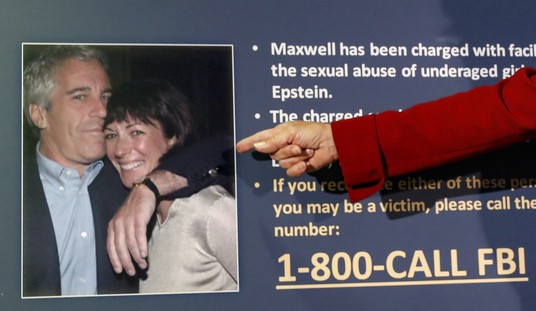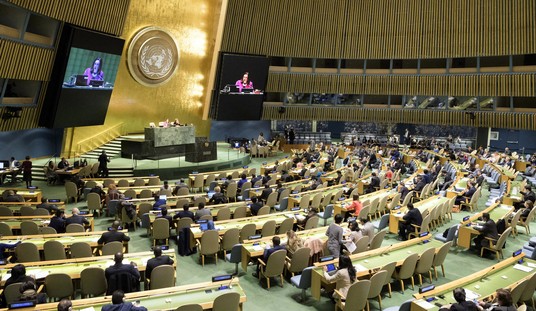It wasn’t all fun and games at the Internet Research Agency, according to reports provided to the Senate Intelligence Agency last week. Two investigations into the Russian operation describe a targeted disinformation campaign that tried to sow division and weaken voter commitment in the months before the 2016 election. The strategies employed by the group, backed by a close crony of Vladimir Putin, focused on key demographics — mainly conservatives and African-Americans:
The Russian influence campaign on social media in the 2016 election made an extraordinary effort to target African-Americans, used an array of tactics to try to suppress turnout among Democratic voters and unleashed a blizzard of posts on Instagram that rivaled or exceeded its Facebook operations, according to a report produced for the Senate Intelligence Committee. …
The Russian influence campaign in 2016 was run by a St. Petersburg company called the Internet Research Agency, owned by a businessman, Yevgeny V. Prigozhin, who is a close ally of President Vladimir V. Putin of Russia. Mr. Prigozhin and a dozen of the company’s employees were indicted last February as part of the investigation of Russian interference by Robert S. Mueller III, the special counsel.
Both reports stress that the Internet Research Agency created social media accounts under fake names on virtually every available platform. A major goal was to support Donald Trump, first against his Republican rivals in the presidential race, then in the general election, and as president since his inauguration.
Creating accounts designed to pass as belonging to Americans, the Internet Research Agency spread its messages not only via Facebook, Instagram and Twitter, which have drawn the most attention, but also on YouTube, Reddit, Tumblr, Pinterest, Vine and Google+, among other platforms. Its attack on the United States used almost exclusively high-tech tools created by American companies.
The IRA was not just a band of Merry Pranksters, according to the New Knowledge analysis. CNN reports that the Russians wanted to find ways to develop their intelligence operations in the US, and used the disinformation campaign to develop new “assets”:
CNN obtained one of the reports in advance of its release. That report was prepared by New Knowledge, a firm that tracks disinformation online. New Knowledge found that the IRA’s efforts went beyond the digital, as the group regularly tried to co-opt unsuspecting Americans to complete real-world tasks or hand over their personal information. CNN and other outlets have previously reported on some efforts like this, but others included in the New Knowledge report had not previously been made public.
In one instance, through its page “Army of Jesus,” which was targeting Christians, the group offered “free counseling to people with sexual addiction,” New Knowledge found.
The phony counseling service could have created an opportunity to blackmail or manipulate individuals who availed of it, the report notes.
“Recruiting an asset by exploiting a personal vulnerability — usually a secret that would inspire shame or cause personal or financial harm if exposed — is a timeless espionage practice,” it says.
Was anyone stupid enough to fall for that ploy? Only those silly enough to join the “Army of Jesus,” maybe, an all-time winner in the oxymoron sweepstakes. One would have to think that the target audience for that and other social-media memes created by IRA would not intersect at all with the population of potential “valuable assets” in a Venn diagram.
However, the execution in this case matters less than the intent. If New Knowledge is correct, the Russians had a longer game in mind than just the 2016 campaign. They wanted to infiltrate American society and look for long-range assets through extortion or perhaps just honey-pot operations — “timeless” strategies with infinite possibilities in cyberspace.
That may well have be a link to the Maria Butina case, perhaps even operationally. The Russian national has cut a deal with prosecutors and pled guilty on Thursday to conspiracy and acting as a foreign agent, called “espionage lite” by some observers. Butina had gotten into a relationship with Paul Erickson, a longtime lobbyist and Republican political mover and shaker. He’s now a target of federal prosecutors too, having allegedly serving as a conduit between Butina and the NRA. That effort was a lot more sophisticated than trolling “Army of Jesus” fans, and one would suspect a lot more effective, too. It doesn’t mean that the Russians saw some value in trying both, though.
So what did the Russians want out of the IRA, other than expand the scope of asset acquisition? The Washington Post suggests that they wanted to drain enthusiasm for Hillary Clinton among African-Americans:
“What is clear is that all of the messaging clearly sought to benefit the Republican Party — and specifically Donald Trump,” the report says. “Trump is mentioned most in campaigns targeting conservatives and right-wing voters, where the messaging encouraged these groups to support his campaign. The main groups that could challenge Trump were then provided messaging that sought to confuse, distract and ultimately discourage members from voting.” …
The Russians aimed particular energy at activating conservatives on issues such as gun rights and immigration, while sapping the political clout of left-leaning African American voters by undermining their faith in elections and spreading misleading information about how to vote. Many other groups — Latinos, Muslims, Christians, gay men and women, liberals, Southerners, veterans — got at least some attention from Russians operating thousands of social media accounts.
How effective was it? Er, not terribly, if one compares exit polling from 2012 to 2016. African-American voters comprised 13% of the presidential electorate in 2012 and 12% four years later, a difference that’s well within margins of error as well as perhaps explained by Barack Obama’s presence on the 2012 ballot.
Let’s look more specifically at where Hillary lost. Poor Democratic turnout in the “blue wall” states of Wisconsin, Michigan, and Pennsylvania doomed Clinton’s bid, so if this was determinative, it would have to have been determinative there. In Wisconsin, both elections had the same percentage of African-American voters while Hillary lost over 230,000 votes from Obama’s totals, suggesting that demographics had little to do with it. Hillary lost 280,000 in Michigan off Obama’s totals while the percentage of black voters dropped from 18% to 15%, but Latinos went up from 3% to 5% and they went for Clinton 59/38. In Pennsylvania, the African-American percentage dropped three percentage points to 10% while the Latino contingent stayed constant, but was that because of Russian propaganda — or Hillary Clinton’s poor performance and Barack Obama’s departure from office?
Worth noting: in 2004 exit polling, the African-American vote in Michigan accounted for 13% of the electorate, below both 2012 and 2016 levels. That’s not true in Pennsylvania, though, where 2004’s 13% is what Obama drew in 2012. Was that the Russians, or was it Hillary? It’d be tough to prove either theory, but her losses in Wisconsin and Michigan certainly point to a more domestic conclusion. Bet your bottom dollar, though, that Clinton and her apologists will argue the other theory from now until the end of time.








Join the conversation as a VIP Member